It looks like you're using an Ad Blocker.
Please white-list or disable AboveTopSecret.com in your ad-blocking tool.
Thank you.
Some features of ATS will be disabled while you continue to use an ad-blocker.
26
share:
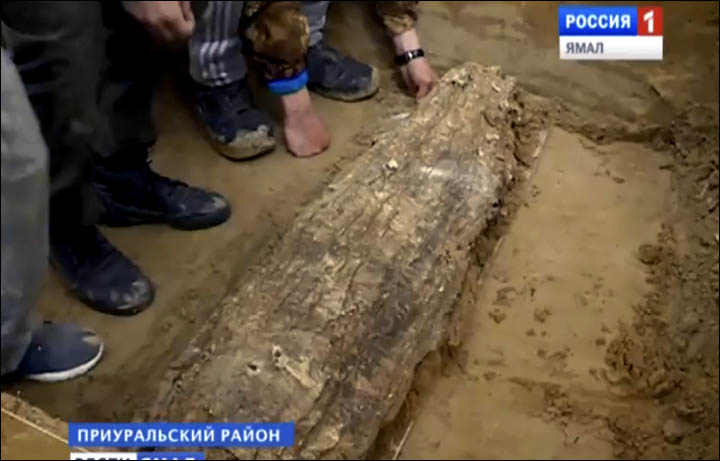
Archeologists working at the site, near Salekhard, say they suspect the remains are of a child or teenager from the 12th or 13th centuries AD. Picture: Vesti.Yamal
unopened human remains are wrapped in birch bark and it is likely that this 'cocoon' contains copper which - combined with the permafrost - produced an accidental mummification.
Archeologists working at the site, near Salekhard, say they suspect the remains are of a child or teenager from the 12th or 13th centuries AD.
The new find matches others discovered at Zeleny Yar, belonging to a mystery medieval civilization with links to Persia despite its position on the edge of the Siberian Arctic. If confirmed, it will be the first mummy from the civilisation found at this intriguing site since 2002.
Fellow of the Research Center for the Study of Arctic, Alexander Gusev, said: 'We decided, after consulting with colleagues, to take the find as a whole piece, that is without opening it in the field, taking for further research in the city.'
Checks with a metal detector show there is indeed metal beneath the birch bark. 'The birch bark 'cocoon' is of 1.30 metres in length and about 30 cm at the widest part.
'It follows the contours of the human body. If there is really a mummy, the head and skull are likely to be in good condition. We think it is a child, maybe a teenager. The find is now in Salekhard, in the Shemanovsky Museum, in special freezer. We plan to return to Salekhard on 15 July and immediately start the opening of the 'cocoon'.
Anthropologist Evgeniya Syatova will be among those examining the discovery which, hope experts, will throw light on this tribe and its origins. She is leading archeologist at the Scientific and Production Center for the Protection and Use of Historical and Cultural Monuments, Sverdlovsk region.
'The mummification was natural,' said Mr Gusev. 'It was combination of factors: the bodies were overlain with copper sheets, parts of copper kettles and together with the permafrost, this it gave the preserving effect.'
Local Vesti.Yamal TV came to the site as the find was made. Their images show it being removed from the ground.
'The find is now in Salekhard, in the Shemanovsky Museum, in special freezer. We plan to return to Salekhard on 15 July and immediately start the opening of the 'cocoon'.' Pictures: Vesti.Yamal
♠______________________________________________________________♠
Previously, archeologists found 34 shallow graves at the medieval site, including 11 bodies with shattered or missing skulls, and smashed skeletons. Five mummies were found to be shrouded in copper, while also elaborately covered in reindeer, beaver, wolverine or bear fur. Among the graves found so far is just one female, a child, her face masked by copper plates. There are no adult women.
Nearby were found three copper masked infant mummies - all males. They were bound in four or five copper hoops, several centimetres wide.
Similarly, a red-haired man was found, protected from chest to foot by copper plating. In his resting place, was an iron hatchet, furs, and a head buckle made of bronze depicting a bear.
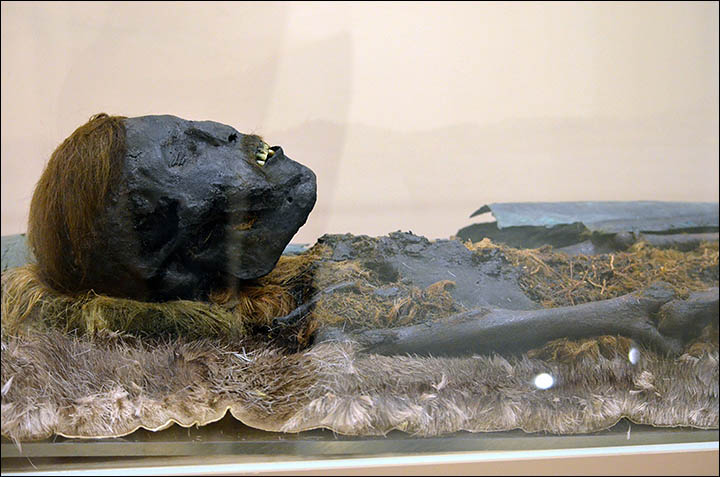
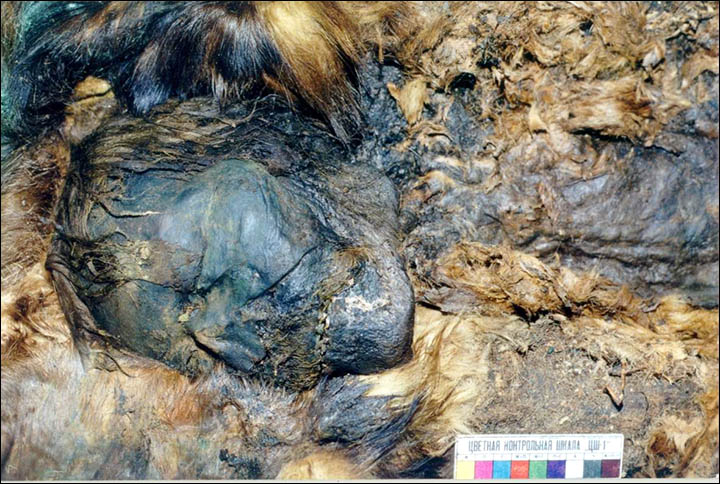
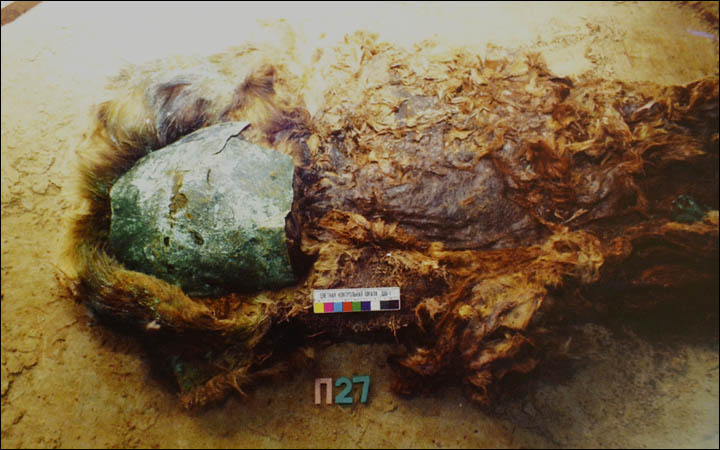
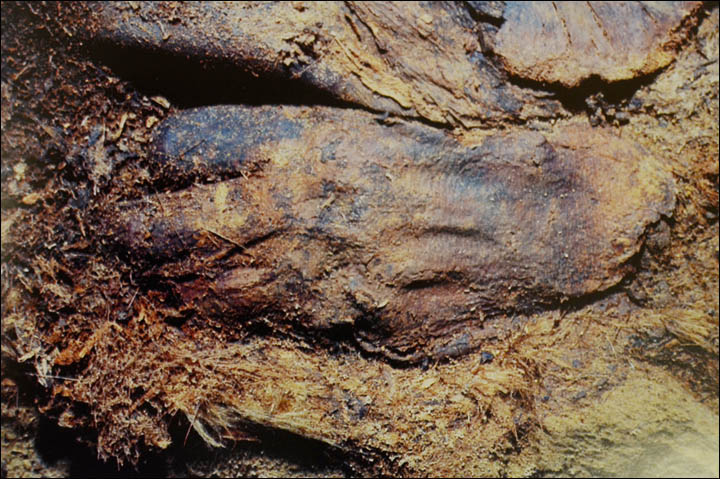
Five mummies were found to be shrouded in copper, while also elaborately covered in reindeer, beaver, wolverine or bear fur. Pictures: The SIberian Times, Natalya Fyodorova
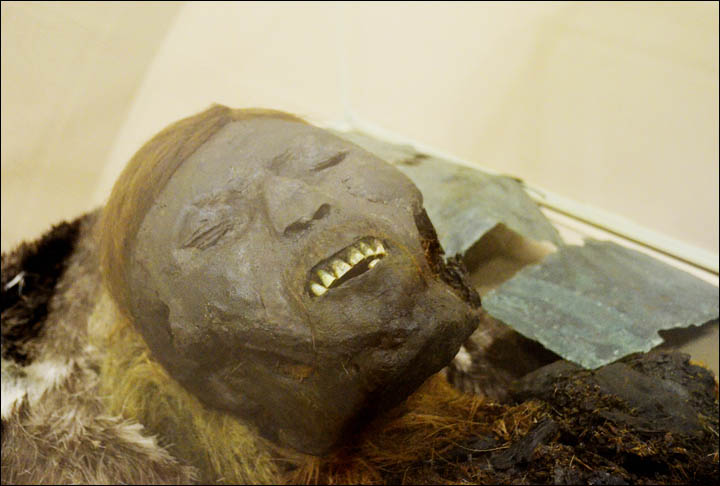
'A red-haired man was found, protected from chest to foot by copper plating. In his resting place, was an iron hatchet, furs, and a head buckle made of bronze depicting a bear.' Pictures: Kate Baklitskaya, Go East
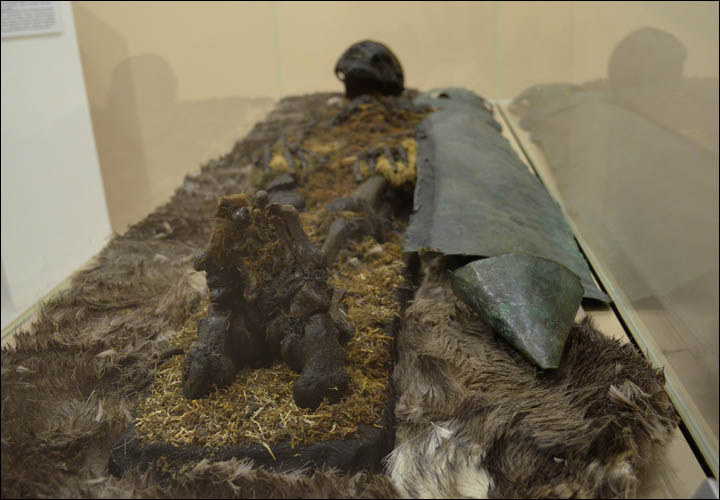
Sourc e
Very interesting , this is the first time I have heard of these discovery's when I have time I am going to delve into this a bit more ,I can't help but to think that they remind me of Vikings .
More reads at the source , If you have any more info to add feel free !
Thanks Much !
Kap
edit on 06/17/2015 by Kapusta because: (no reason given)
edit on 06/17/2015 by Kapusta because: (no reason given)
a reply to: Kapusta
Well during the Middle Ages there were rumors of a civilization in the East, I wonder if this is the civilization they are talking about,
en.wikipedia.org...
Well during the Middle Ages there were rumors of a civilization in the East, I wonder if this is the civilization they are talking about,
Prester John (Latin: Presbyter Johannes) is a legendary Christian patriarch and king popular in European chronicles and tradition from the 12th through the 17th century. He was said to rule over a "Nestorian" (Church of the East) Christian nation lost amid the Muslims and pagans of the Orient, in which the Patriarch of the Saint Thomas Christians resided. The accounts are varied collections of medieval popular fantasy, depicting Prester John as a descendant of the Three Magi, ruling a kingdom full of riches, marvels, and strange creatures.
At first, Prester John was imagined to reside in India; tales of the Nestorian Christians' evangelistic success there and of Thomas the Apostle's subcontinental travels as documented in works like the Acts of Thomas probably provided the first seeds of the legend. After the coming of the Mongols to the Western world, accounts placed the king in Central Asia, and eventually Portuguese explorers convinced themselves that they had found him in Ethiopia, which had been officially Christian since the 4th century. Prester John's kingdom was thus the object of a quest, firing the imaginations of generations of adventurers, but remaining out of reach. He was a symbol to European Christians of the Church's universality, transcending culture and geography to encompass all humanity, in a time when ethnic and inter-religious tension made such a vision seem distant.
en.wikipedia.org...
edit on 4-7-2015 by starwarsisreal because: (no reason given)
a reply to: starwarsisreal
I'm not sure the arctic is close enough to the Orient for that to be the answer, but its an interesting one. Considering what we know about migrations from Indo-china to South America could it be possible that these are some of that group?
Or, and this is a wild possibility, there are stories out of the American west about red haired giants....and it wouldn't be inconceivable for them to cross from Russia to Alaska considering there was a land bridge there.
Fun fact, the South Americans had copper death masks.
I'm not sure the arctic is close enough to the Orient for that to be the answer, but its an interesting one. Considering what we know about migrations from Indo-china to South America could it be possible that these are some of that group?
Or, and this is a wild possibility, there are stories out of the American west about red haired giants....and it wouldn't be inconceivable for them to cross from Russia to Alaska considering there was a land bridge there.
Fun fact, the South Americans had copper death masks.
edit on 4-7-2015 by Thorneblood because:
edit on 4-7-2015 by Thorneblood because: (no reason given)
edit on
4-7-2015 by Thorneblood because: (no reason given)
Concerning an Iranian connection, I remember reading somewhere years ago that the Iranians were originally blond and blue-eyed, and came down from the
far north.
Great pics, creepy though! I'm just amazed at how wonderful his teeth are! Look at those prime chompers, all without flouride in the water... Or
coke... Makes you wonder a bit....
originally posted by: punkinworks10
a reply to: Qumulys
The very good condition of the teeth is due to the meat heavy diet.
Due to lack of sugar.
a reply to: Char-Lee
And no flouride either Sugar really is an awful product, an awful delicious addictive product... I need a chocy bar brb. I think nuts and chomping on bones as well may be helping them. They seem perfectly in line and level, nothing like how they have been depicted in some old movies. I'm very jealous.
And no flouride either Sugar really is an awful product, an awful delicious addictive product... I need a chocy bar brb. I think nuts and chomping on bones as well may be helping them. They seem perfectly in line and level, nothing like how they have been depicted in some old movies. I'm very jealous.
a reply to: Char-Lee
Mostly plant sugars. For people in pre agricultural hunting societies tooth decay is rare. It shows in historic native American remains, teeth from before they started sedentary or agricultural lifestyles have very few cavities.
And in early agricultural communities or foragers where they use stone to grind grain or roots, tooth wear and decay is very pronounced
Mostly plant sugars. For people in pre agricultural hunting societies tooth decay is rare. It shows in historic native American remains, teeth from before they started sedentary or agricultural lifestyles have very few cavities.
And in early agricultural communities or foragers where they use stone to grind grain or roots, tooth wear and decay is very pronounced
a reply to: Kapusta
Pretty cool. And the whole copper burial, I dont think if its that old that they would just leave what would be pretty precious metal behind if it were not important. But anyways, strange custom to have half a world away in the more cold part of the world.
But ya, look at them chompers on that one in the picture, hundreds of years old and still in better condition then most in this day and age. Got to stay away from them acidic drinks, but its so hard to do this day and age.
I wonder will people in the future call this age the coke and pepsi age. Funny when you think about it when people hundreds of years ago or even thousands, well you could say that in a way, they had better dental plans then we do.
Pretty cool. And the whole copper burial, I dont think if its that old that they would just leave what would be pretty precious metal behind if it were not important. But anyways, strange custom to have half a world away in the more cold part of the world.
But ya, look at them chompers on that one in the picture, hundreds of years old and still in better condition then most in this day and age. Got to stay away from them acidic drinks, but its so hard to do this day and age.
I wonder will people in the future call this age the coke and pepsi age. Funny when you think about it when people hundreds of years ago or even thousands, well you could say that in a way, they had better dental plans then we do.
edit on 5amSundayam052015f0amSun, 05 Jul 2015 05:05:42 -0500 by galadofwarthethird because: (no reason given)
originally posted by: Lazarus Short
Concerning an Iranian connection, I remember reading somewhere years ago that the Iranians were originally blond and blue-eyed, and came down from the far north.
The area in question would have encompased the central steppes, vital for nomadic horsemen. From there, it is a straight run northwards towards the arctic circle so links to Iran (more nomadic horsemen) is not suprising.
originally posted by: starwarsisreal
a reply to: Kapusta
Well during the Middle Ages there were rumors of a civilization in the East, I wonder if this is the civilization they are talking about,
Prester John (Latin: Presbyter Johannes) is a legendary Christian patriarch and king popular in European chronicles and tradition from the 12th through the 17th century. He was said to rule over a "Nestorian" (Church of the East) Christian nation lost amid the Muslims and pagans of the Orient, in which the Patriarch of the Saint Thomas Christians resided. The accounts are varied collections of medieval popular fantasy, depicting Prester John as a descendant of the Three Magi, ruling a kingdom full of riches, marvels, and strange creatures.
At first, Prester John was imagined to reside in India; tales of the Nestorian Christians' evangelistic success there and of Thomas the Apostle's subcontinental travels as documented in works like the Acts of Thomas probably provided the first seeds of the legend. After the coming of the Mongols to the Western world, accounts placed the king in Central Asia, and eventually Portuguese explorers convinced themselves that they had found him in Ethiopia, which had been officially Christian since the 4th century. Prester John's kingdom was thus the object of a quest, firing the imaginations of generations of adventurers, but remaining out of reach. He was a symbol to European Christians of the Church's universality, transcending culture and geography to encompass all humanity, in a time when ethnic and inter-religious tension made such a vision seem distant.
en.wikipedia.org...
There were many civilaztions in the East but this sounds very much like the Khwarezm Empire (Khwarezm Empire) which did rather well for itself until they annoyed Genghis (repeatedly) - turned out to be one of the most costly mistakes in history.
new topics
-
Planned Civil War In Britain May Be Triggered Soon
Social Issues and Civil Unrest: 30 minutes ago -
Claim: General Mark Milley Approved Heat and Sound Directed Energy Weapons During 2020 Riots
Whistle Blowers and Leaked Documents: 2 hours ago
top topics
-
Claim: General Mark Milley Approved Heat and Sound Directed Energy Weapons During 2020 Riots
Whistle Blowers and Leaked Documents: 2 hours ago, 3 flags -
Planned Civil War In Britain May Be Triggered Soon
Social Issues and Civil Unrest: 30 minutes ago, 1 flags
active topics
-
Claim: General Mark Milley Approved Heat and Sound Directed Energy Weapons During 2020 Riots
Whistle Blowers and Leaked Documents • 8 • : rickymouse -
Ukraine halts transit of Russian gas to Europe after a prewar deal expired
Political Conspiracies • 145 • : Oldcarpy2 -
Sorry to disappoint you but...
US Political Madness • 37 • : matafuchs -
The Truth about Migrant Crime in Britain.
Social Issues and Civil Unrest • 24 • : angelchemuel -
Gravitic Propulsion--What IF the US and China Really Have it?
General Conspiracies • 25 • : Lazy88 -
Trudeau Resigns! Breaking
Mainstream News • 69 • : KrustyKrab -
Planned Civil War In Britain May Be Triggered Soon
Social Issues and Civil Unrest • 0 • : TimBurr -
Stuck Farmer And His Queue Jumping Spawn
Rant • 10 • : Cvastar -
Joe Biden gives the USA's Highest Civilian Honor Award to Hillary Clinton and George Soros.
US Political Madness • 59 • : mysterioustranger -
Greatest thing you ever got, or bought?
General Chit Chat • 24 • : mysterioustranger
26
